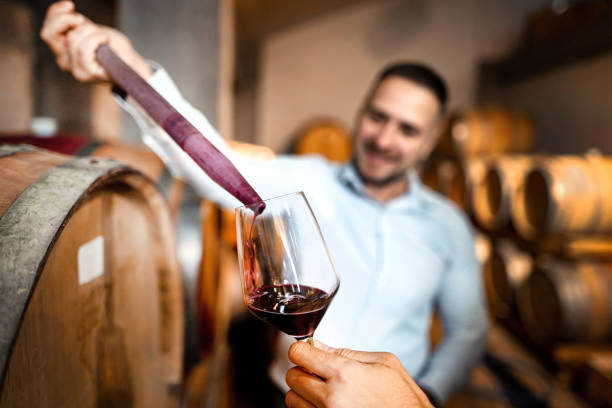China has a long-standing tradition of cultivating grapevines and is one of the locations that gave birth to this Vitis Genus ( Li, 2008). The species include more than Vitis plants across the globe 42 are indigenous to China, including Vitis amurensis located in Northeastern, Northern, and Central China, Vitis flexuosa found in Central as well as Southern China; Vitis davidii in Central and Southwestern China, and Vitis flexuosa that is widely distributed across China ( Li, 2008). Fossils reveal that Vitis romanetti grew within Linqu County, Shandong, China, 26 million years ago. These facts make it difficult to categorize China as a New World wine producer.
The classification of wine-producing countries.
Humans first encountered an uncultivated Eurasian wine vine (Vitis vinifera sylvestris) when they left Africa in the region of modern Lebanon between 60,000 and 100,000 years in the Paleolithic period ( MacNeil, 2015). Methods for making wine and storage were first developed during the Neolithic age from around 8500 to 4000 BC ( Cavalieri et al. 2003). Western experts believe that the Ptah Hotep tomb, which was built around 6000 years ago, depicts scenes of viticulture, the winemaking process, and grape harvesting in the early days of Egypt and thus indicating the beginning of winemaking in the human race ( Mcgovern et al. 1996; Jane, 2011; Vine, 1981).
Since the year 800 BC, winemaking has been prominent in Greece and spread across other Mediterranean regions such as Southern Italy, Campania, Calabria, and Sicily in the Classical Period (600 BCE-400 BCE) of Greek colonization ( Bode, 1992). The grape-growing knowledge and wine-making techniques from the winemaking techniques of the Greeks were brought over from the Nile Delta area. The first record of a wine trade occurred in the year 600 BC when wines from Asia Minor were imported through Marseilles to the Gaul region (now France) by Greeks together with their viticulture and technology of enology ( Laufer, 1940).
The Romans learned their viticulture as well as methods of enology from the Greeks and incorporated them throughout all of the Italian peninsulae. The expansion of the Roman Empire led to viticulture and winemaking technology expanding westward to the rest of Europe, especially France, Spain, and Germany, regions that are now designated as”the “Old World” of wine ( Miller, 2010; Su 2005). Between the 17th and 19th centuries, Spanish and British colonists introduced winemaking and viticulture technologies to nations like South Africa, Australia, New Zealand, and the Americas nations that are currently classified in the category of “New World” wine producers ( Piperno, 2011, Wilson, 1957, Chen, Chen, Mamoru, 2007).
The classification of wine-producing countries became universal after publications like “The World Atlas of Wine” declared that the countries producing wine could be classified into two different worlds: “Old World” and “New World” ( Johnson and Robinson, 2014). Based on”The World Atlas of Wine “World of Atlas of Wine,” Old World countries are wine-producing nations that have a long history in the Mediterranean region, which includes Greece, France, Italy, Spain, Germany, Portugal, Austria, and Hungary. The New World countries are wine-producing nations that have settled following European colonies and comprise those of the United States, Australia, New Zealand, Chile, South Africa, and Argentina. As a binary categorization, it is flawed because it overlooks the history of the country and is based on a Continental European bias.
The French Foreign Trade Advisory Committee ( CNCCEF, 2009) released “Move towards the Wine World of 2050”. Alongside having the “Old World” and “New World” classifications, CNCCEF defined the “New New World” as the most recent nations producing large amounts of wine like China, Brazil, India, Eastern Europe and North Africa. In accordance with the definitions of the CNCCEF, China has been considered to be the “New New World” in the map of wine production around the world despite the fact the cultivation of grapes and wine in China dates back to between 9000 BCE and 7000 BC. The winemaking process and tradition are founded in Chinese culture and history, and the notion of “New New World” is misleading and imposes the Euro orientation to wine’s history and omits facts. To address the misconception, we suggest that Chinese wine isn’t a part belonging to the “New New World” but to a category called “Ancient World” wine producer.
Findings from archaeology
There are numerous physical evidences that verify China’s “ancient” wine-making status. In the year 1980, a sealed copper bottle filled with liquid was discovered in an ancient tomb in Henan Province that dates back to 1200 BCE. Peking University Department of Chemistry identified the liquid as being grape wine ( Henan Provincial Institute of Cultural Relics and Archaeology, (1999)). In 2001 the wine seedlings were discovered on a site at Jiahu (Henan Province). The seeds go between 7000 and 9000 years ago, in the Neolithic Age ( Zhang and Pan 2002). Pottery containing residues of tartrate and tartaric acid, specific to winemaking and tartrate, was examined using Infrared spectroscopy as well as high-performance liquid chromatography; thirteen were found to have wine ingredients ( Mcgovern, 2000). The grape seeds found on the same site suggest that grapes may have been used to make the drink. This is the first scientifically proven evidence of grapes being utilized in a fermentation-based beverage ( Lv and Zhang 2013, 2013). This is a significant deviation from the widely accepted “history of wine.”
At the Jiahu site, different types of pottery and vessels were discovered, comprising coarse clay carbon, ceramic, and mica. Aside from the traditional ceramics that have flat bottoms, certain pottery are sharp and have bottoms that suggest they are used as vessels to ferment wine (Helan 1999). Relics of containers discovered in an ancient tomb in Minfeng, Xinjiang Uygur Autonomous Region, which date from around 200BCE to 400BC, are adorned by grape clusters, dried and fresh grapes. Minfeng is the city of ancient times of Niya, which was as described in the work of Marc A. Stein in his book “On Ancient Central Asian Tracks in the form of “tidy plots of vineyards sites outside the courtyards of houses.” ( Stein 1993, p. 298).
The wine culture in China
According to Chinese documents, the alcohol production and the alcohol tradition in the central and southern areas, which is now Shanxi province, date from the middle of the Xia Dynasty (2070BCE-1600BCE). Shao Kang (also called Du Kang), one of the emperors from the Xia Dynasty, was the earliest recorded winemaker. The drink that Shao Kang made was composed of the fermentation of grain mashing, along with various types of fruits. This mixture most likely contained grapes since Shanxi is one of the most important regions for the cultivation of wine grapes in China.
The earliest recorded account of grapes in China can be found in Shi Jing (The Book of Poetry) written by Confucius. Shi Jing contains 305 poems starting from the start period of the Western Zhou Dynasty to the middle of the Autumn and Spring Period (1100BCE-600BCE). Within the 305 poems, it is notable that the phrase “wine” (Jiu, alcoholic beverage) is used over 60 times. It describes how people drank the berries of wild grapes. Zhou Li is one of the 13 books that are part of Confucianism, composed during the Zhou Dynasty (1046BCE-256BCE) and revised in the Warring Period (476BCE-221BCE). The “Zhou Local Official List” of Zhou Li (2014 edition, and annotated in 2014 edition, annotated by Xu, Zh., Chang, P.) It is stated it states that “the people who were in charge of Chang Pu area harvested and stored different fruits such as melon, grapes,” and thus implies that the people of that time had their own vineyards and were able to master the art of storing fruit.




